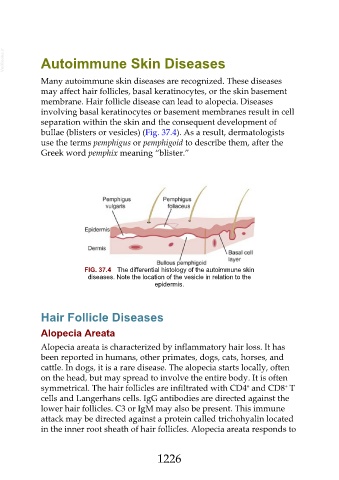Page 1226 - Veterinary Immunology, 10th Edition
P. 1226
VetBooks.ir Autoimmune Skin Diseases
Many autoimmune skin diseases are recognized. These diseases
may affect hair follicles, basal keratinocytes, or the skin basement
membrane. Hair follicle disease can lead to alopecia. Diseases
involving basal keratinocytes or basement membranes result in cell
separation within the skin and the consequent development of
bullae (blisters or vesicles) (Fig. 37.4). As a result, dermatologists
use the terms pemphigus or pemphigoid to describe them, after the
Greek word pemphix meaning “blister.”
FIG. 37.4 The differential histology of the autoimmune skin
diseases. Note the location of the vesicle in relation to the
epidermis.
Hair Follicle Diseases
Alopecia Areata
Alopecia areata is characterized by inflammatory hair loss. It has
been reported in humans, other primates, dogs, cats, horses, and
cattle. In dogs, it is a rare disease. The alopecia starts locally, often
on the head, but may spread to involve the entire body. It is often
+
+
symmetrical. The hair follicles are infiltrated with CD4 and CD8 T
cells and Langerhans cells. IgG antibodies are directed against the
lower hair follicles. C3 or IgM may also be present. This immune
attack may be directed against a protein called trichohyalin located
in the inner root sheath of hair follicles. Alopecia areata responds to
1226

